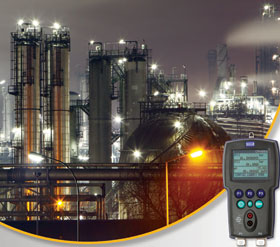

When one looks objectively, most industrial plants constitute a hazardous zone. Many materials essential for process operation, and also finished products, are flammable or explosive. The more of these materials are needed for the manufacturing process or are generated – for example in chemical, petrochemical or even food industries – the higher is the risk and the more far-reaching the safety measures. Any spark or overheating can lead to an explosion with fatal consequences. High-quality measurement and control technology in industrial plants serves as prevention and their routine calibration is increasingly taking place in the plant, for example using portable pressure calibrators. However, the requirements placed on the reference instrument for a check in an Ex (potentially explosive) area are high.
Depending on the explosion hazard, the corresponding areas in industry are divided into three zones. In the IEC 60079-10-1 standard these are defined as follows:
* Zone 0: An area in which an explosive atmosphere is present permanently, for a long duration or frequently.
* Zone 1: An area in which it can be expected that an explosive atmosphere will occur, in normal operation, periodically or occasionally.
* Zone 2: An area in which it is not expected that an explosive atmosphere will occur in normal operation. Should one occur, then it will only be for a short time.
Calibrators for on-site testing must be approved for the respective zone. Thus, instruments for zone 0 are naturally subject to higher requirements than those for zone 1 or zone 2.
Explosive atmospheres cannot always be completely avoided. Thus, measures must be taken to prevent their ignition; these are dependent on the zone classification. Fundamentally, ignition sources should be avoided in hazardous areas. In this are included calibrators without the appropriate approval, which could trigger an explosion as a result of friction or impact sparks, or from an electrostatic discharge.
This hazard potential in a calibrator can be prevented through suitable materials and design measures. Thus, for example, EMC-protected ABS plastic is used, in order to prevent static discharge from the calibrator enclosure during handling.
The ‘Ex suitability’ of an instrument is guaranteed with the ATEX certificate. Underlying this is directive 94/9/EC of the European Community, to avoid unwanted explosions in industry. Within this, all relevant requirements for calibrators, equipment and components are laid down. If calibrators are developed, designed and built in accordance with this directive, they can be subjected to a uniform EC-type examination. If it passes this, the instrument is granted an ATEX certificate and can be used to calibrate process parameters in explosion hazard areas.
However, it should be noted that explosion-proof test equipment should itself only be tested using intrinsically safe calibrators. This is because their comprehensive method of protection is based primarily on specific electronic components that ensure that the calibrator can neither generate a spark nor an ignition temperature. The circuits in instruments such as the WIKA model CPH65I0 are all current and voltage limited. Their energy is thus also limited so that, even in a fault condition, any danger of ignition is eliminated.
Intrinsically safe calibrators, are divided into three different levels of protection ‘ia’, ‘ib’ and ‘ic’. An instrument with classification ‘ia’ has two redundant components (ie, with the failure of two safety-critical components, a third provides their function). For protection level ‘ib’ there is only one, and with ‘ic’ there is no redundant component.
However, reliability is not the only criterion for using intrinsically safe calibrators: they enable the highest possible accuracy at the same time as secure protection. If, for example, an ATEX-approved process transmitter was tested with a non-intrinsically safe calibrator, damage from unlimited current and voltage outputs could not be excluded. Against this risk, for non-intrinsically safe calibrators, a safety barrier (such as a zone separator) would have to be interposed. Such protective devices, however, affect the accuracy of measurement, so that errors would have to be considered in the calibration. Intrinsic safety makes such considerations redundant.
The demand for portable calibrators in hazardous areas is increasing, since explosion-proof test items can remain in the plant but can still be calibrated precisely. On-site calibration results in relatively short process interruptions saving time and thus money.
| Tel: | +27 11 621 0000 |
| Email: | [email protected] |
| www: | www.wika.co.za |
| Articles: | More information and articles about WIKA Instruments |

© Technews Publishing (Pty) Ltd | All Rights Reserved